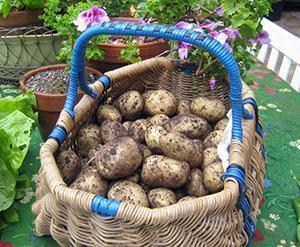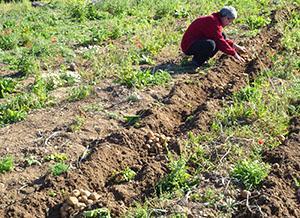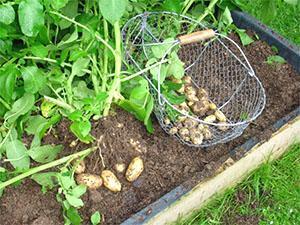Potato ripening time
 The optimal time for harvesting potatoes is considered to be the time when the tops have already completely withered and died. Indeed, when the foliage begins to turn brown and dry, the development of both the aboveground and underground parts of the plant slows down, and then completely stops. The tubers that have grown up to this point form a firm peel and accumulate the proper amount of nutrients. The connection between potatoes and stolons is weakening. That is, the time comes when you can dig up potatoes without fear of serious damage to the tubers.
The optimal time for harvesting potatoes is considered to be the time when the tops have already completely withered and died. Indeed, when the foliage begins to turn brown and dry, the development of both the aboveground and underground parts of the plant slows down, and then completely stops. The tubers that have grown up to this point form a firm peel and accumulate the proper amount of nutrients. The connection between potatoes and stolons is weakening. That is, the time comes when you can dig up potatoes without fear of serious damage to the tubers.
The relationship between the choice of variety and the timing of harvesting potatoes

According to the rate of ripening and growing season, potatoes can be divided into several categories:
- Early maturing varieties ready for digging in 50-65 days.
- Vegetation of medium early potatoes lasts from 65 to 80 days.
- Mid-season varieties give a high-quality harvest in 80–95 days.
- Mid-late potatoes remain in the soil for 95 to 110 days before ripening.
- In late-ripening varieties, the longest time passes before harvesting potatoes - at least 110 days.
Therefore, in each case, the selection of a variety for planting is carried out individually. Moreover, among the decisive criteria are not only the ripening period of the potato and its growing season, but also the purpose of the variety, its taste, the ability to withstand winter storage.
Factors affecting the timing of potato ripening
 Even when planting tubers of the same variety, gardeners cannot be sure that the collection of potatoes will be carried out at the same time.
Even when planting tubers of the same variety, gardeners cannot be sure that the collection of potatoes will be carried out at the same time.
- The introduction of excessive amounts of organic matter delays the growing season of the bushes, and when young potatoes are excavated, an increased content of nitrates may be found in the tubers.
- The poorer the soil, the sooner the time comes when you can dig potatoes. On fertile soil, the vegetation of plants, which means that the growth and development of tubers can continue until late autumn.
- On dried up soil, chronically lacking moisture, the ripening period for potatoes is also reduced. Already in the middle of summer, on plantations where the plants did not have enough watering, you can see drooping yellow stems or even wilted bushes.
In the first case, there is a risk of getting an unripe crop by autumn, which is not able to withstand winter storage. And in the second and third scenarios, the tubers will be extremely small, or all of them will be small.
The goal of any gardener is a high yield that is perfectly stored all winter. For this, it is important that the tubers mature, gain weight, form a dense peel and accumulate useful substances.
 How to determine when to dig potatoes? Focusing on the drying and dying off of the tops, it is important to remember:
How to determine when to dig potatoes? Focusing on the drying and dying off of the tops, it is important to remember:
- keeping the tubers in the soil for more than three weeks after the greens have dried up does not make sense;
- later harvesting of potatoes will lead to the fact that the tubers will become worse stored;
- if the stems and leaves, despite the approaching cold, are green, measures must be taken to accelerate the ripening of the tubers.
If early frosts did damage the plants, then it is better to collect potatoes without delay. Otherwise, nutrients from the tubers will be used to restore the tops.
Mowing tops and other ways to bring potatoes to maturity
 One of the simplest ways to avoid the situation when you have to dig new potatoes in the fall is to mow the green tops. This often happens with late planting or wet summers. As a result, tubers that have not formed a skin are easily injured and poorly stored. If it is impossible to wait with the harvesting of potatoes, then at least 7-10 days before digging the tops are carefully mowed. For the plant, this becomes a sign of the end of the growing season, and the tubers ripen. The same procedure is done if you have to use a potato digger or walk-behind tractor during harvesting.
One of the simplest ways to avoid the situation when you have to dig new potatoes in the fall is to mow the green tops. This often happens with late planting or wet summers. As a result, tubers that have not formed a skin are easily injured and poorly stored. If it is impossible to wait with the harvesting of potatoes, then at least 7-10 days before digging the tops are carefully mowed. For the plant, this becomes a sign of the end of the growing season, and the tubers ripen. The same procedure is done if you have to use a potato digger or walk-behind tractor during harvesting.
To obtain marketable potatoes in the early stages, chemicals are also used today.
- When desiccation is carried out, two weeks before harvesting potatoes, the ridges are sprayed with diluted copper sulfate at the rate of 5 grams per liter of water. The chemical literally draws moisture from the greenery, causing the leaves to become stained and then curl and dry out.
- At the end of a long, cool summer, accompanied by frequent precipitation, the tops are treated with magnesium chlorate. The product is made at the rate of 20 grams of chemical per liter of water. If the weather remains dry, then after 5 days the green part of the plants dries up.
- Spraying potato bushes with superphosphate at the rate of 2 kg of the product per 10 liters of water helps to accelerate the aging of the tops. Irrigation is carried out in the daytime or in the evening after the flowering period, while 5 to 10 liters of the chemical are consumed per hundred square meters.
 These techniques will help you get quality tubers in the summer, when digging young potatoes is especially risky due to the high probability of mechanical damage.
These techniques will help you get quality tubers in the summer, when digging young potatoes is especially risky due to the high probability of mechanical damage.
Most of all, the acceleration of ripening is justified in peatlands and low-lying areas, where it is difficult to get a ripe harvest in a rainy summer.
Weather conditions when digging potatoes
The best time to dig up tubers is in dry, warm weather, when you can dig the potatoes and sort them right away. The crop dries quickly, is cleaned of soil residues and does not freeze.
 If the rainy season is approaching, it is better not to delay cleaning. Since excess moisture at the end of the growing season can provoke potato diseases, the appearance of rot on damaged areas and negatively affect the shelf life.
If the rainy season is approaching, it is better not to delay cleaning. Since excess moisture at the end of the growing season can provoke potato diseases, the appearance of rot on damaged areas and negatively affect the shelf life.
The optimal temperature conditions for harvesting potatoes are in the range from 10 to 17 degrees. Since a one-time cold snap and persistent frosts can not only damage the tops, but also harm the tubers. For this reason, you should not dig potatoes in the early autumn morning, when the air becomes noticeably cooler than the ground.
Harvesting by hand and with a potato digger
 Depending on the area of the site and personal preferences, gardeners choose a shovel, pitchfork, plow as a tool for harvesting potatoes, walk-behind tractor or specialized potato diggers. With a pitchfork, you can pry off all the tubers formed on the bush. Damage from this tool is minimal and easier to work with. But if the tuber is nevertheless damaged, unlike a potato cut with a shovel, it cannot be stored and must immediately go for processing. In addition, when using a pitchfork, small potatoes are often not picked out of the ground.
Depending on the area of the site and personal preferences, gardeners choose a shovel, pitchfork, plow as a tool for harvesting potatoes, walk-behind tractor or specialized potato diggers. With a pitchfork, you can pry off all the tubers formed on the bush. Damage from this tool is minimal and easier to work with. But if the tuber is nevertheless damaged, unlike a potato cut with a shovel, it cannot be stored and must immediately go for processing. In addition, when using a pitchfork, small potatoes are often not picked out of the ground.
When digging young potatoes on loose soil, it is often enough to pull on the stems of the potato bush so that most of the tubers appear on the surface, while the rest are removed with a pitchfork and a shovel. On dense, heavy soils, the bush is undermined by introducing the blade from the side to save the tubers.
These rules work in small areas, but if the plantation is large, you cannot do without specialized equipment. A self-made potato digger or factory device can greatly facilitate the process, reducing not only labor costs, but also the time for harvesting tubers.
 Working with a potato digger requires adherence to some principles.
Working with a potato digger requires adherence to some principles.
- Mechanization is effective if the rows of bushes are even.
- The distance allows not to damage neighboring plants when guiding the digger.
- During work, it is important to make sure that the digger for the potatoes runs easily, and that potatoes remain on the ground after the passage. If the depth is incorrect, the job will either be made more difficult by excessive dumping or some crop will be lost.
Whatever the potatoes are harvested, manually or with the help of mechanical devices, after harvesting the tubers, they must be sorted, removing diseased and damaged potatoes. And if necessary, right there by varieties, planting material is selected for the next season.
The article is very useful for gardeners, since all the subtleties in harvesting a root crop are analyzed in detail. Choosing the right potato varieties is one of the main measures for obtaining a healthy and mature harvest. However, sometimes circumstances, in the form of impending bad weather, do not leave time for preparing potatoes in the ground for harvesting. It is known that dry tubers from the ground are stored much better than those raised after a prolonged bad weather. Therefore, considering that everything in the article is correct, I can share my experience of harvesting potatoes with green tops for winter storage.
Green tops may not only be a sign of late planting or overfeeding with nitrogen fertilizers. It happens that a healthy bush gains mass in favorable conditions longer than it should be for a week, and this is significant in the fall. In this case, the tops should be mowed the day before. Potatoes are taken from the bush only after being turned over with a pitchfork, and picked by hand without knocking on the bucket. Then the skin will be preserved, the tuber will not crack. But for the same 10 days, the potatoes should be in bulk in a dark, cool room. During this time, the peel will harden, flaws will appear. Now you can lower the potatoes into the cellar.
Good day. Recently I bought new green potatoes at the market. And outside it is green and inside. I bought it expensively (January), but I'm afraid to cook it. Are young potatoes green, and if so, can they be cooked?
As I understand it, you mean that when you peel, the white part under the skin is also colored green? This is a fairly common occurrence when tubers are not properly stored and for a long time they are exposed to sunlight. Washed young potatoes also quickly "turn green" or when there was an excess of fertilizers during cultivation. Green color is a high content of the toxic substance solanine. It is recommended not to eat such potatoes, because an excess of toxin can lead to indigestion, at least. However, I am familiar with cases when the green part was cut off to white pulp, boiled and ate without any consequences. After all, to get a negative reaction, you need to eat more than 2 kg of green, unpeeled potatoes. However, I have no right to insist and use it or not - it's up to you.